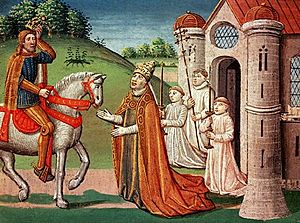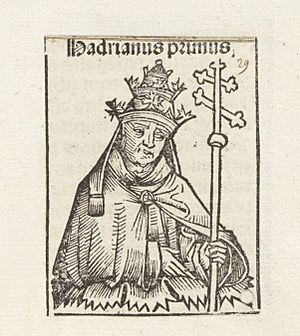Pope Adrian I facts for kids
Quick facts for kids Pope Adrian I |
|
|---|---|
| Bishop of Rome | |
| Church | Catholic Church |
| Papacy began | 1 February 772 |
| Papacy ended | 25 December 795 |
| Predecessor | Stephen III |
| Successor | Leo III |
| Orders | |
| Consecration | 9 February 772 |
| Personal details | |
| Born | 700 Rome, Exarchate of Ravenna, Byzantine Empire |
| Died | 25 December 795 (aged 95) Rome, Papal States |
| Other Popes named Adrian | |
Pope Adrian I (Latin: Hadrianus I) was the leader of the Catholic Church and ruler of the Papal States from 772 until his death in 795. He was born in Rome and was the son of a Roman nobleman named Theodore.
During his time as Pope, Adrian I faced challenges from the Lombards, a Germanic people who wanted to expand their lands in Italy. The Popes often looked to the Franks, another powerful group, for help. Adrian's time as Pope also saw important events involving the famous Frankish king, Charlemagne.
Contents
Pope Adrian I's Early Years
Soon after Adrian became Pope in 772, the Lombards, led by their king Desiderius, attacked lands controlled by the Pope. Adrian asked for help from the Frankish king Charlemagne. Charlemagne brought a large army into Italy.
Charlemagne surrounded Desiderius in his capital city, Pavia. After a long siege, Charlemagne captured the city. He sent the Lombard king away and took the title "King of the Lombards" for himself.
The Pope gained more land, including parts of the Duchy of Rome and the Exarchate of Ravenna. He also received the Duchy of the Pentapolis, which included five cities along the Adriatic Sea coast. To celebrate these new lands, Pope Adrian I created the first papal coin. He also started dating his official documents by Charlemagne's reign, not the Byzantine Emperor's. This showed a shift in power and alliances.
Working with Other Nations
Lombards and Franks
The Popes had always been cautious of the Lombards. They often sought help from the Byzantine Empire to keep the Lombards from becoming too powerful. When the Byzantine Empire couldn't offer much help, Pope Adrian I turned to the Franks.
A Family Feud and New Alliances
When Pepin the Short, Charlemagne's father, died in 768, his kingdom was divided between his sons, Charlemagne and Carloman I. The brothers did not get along well.
In 770, the Duke of Bavaria married a Lombard princess, King Desiderius's daughter. This strengthened the alliance between Lombardy and Bavaria. Charlemagne then married Desiderius's other daughter, trying to surround Carloman with his own allies.
However, less than a year later, Charlemagne ended his marriage to Desiderius's daughter. He married a different woman named Hildegard. This deeply offended King Desiderius. He then formed an alliance with Carloman against Charlemagne and the Pope.
Charlemagne's Invasion of Italy
Carloman died in December 771. Charlemagne quickly took over his brother's lands. Carloman's wife and two sons fled to the Lombard court in Pavia.
King Desiderius asked Pope Adrian to recognize Carloman's sons as the rightful kings of the Franks. The Pope refused. Desiderius then invaded the Duchy of the Pentapolis, which Charlemagne's father had given to the Pope.
Charlemagne, who was busy fighting elsewhere, saw this as a threat. In 773, he quickly crossed the Alps and surrounded Pavia. The Lombards surrendered, and Desiderius was sent away. Charlemagne then took the title "King of the Lombards."
Friendship with the Franks
From 781, Pope Adrian I began dating papal documents using the years of Charlemagne's reign. This showed the strong bond between them.
Their friendship remained strong, even when they had a disagreement about religious images. In 787, a church council approved the use of icons (religious images). Charlemagne, however, had received a poor translation of the council's decisions. He sent a letter to the Pope, criticizing some parts of the council's acts. Pope Adrian I defended the council's decisions. Despite this, their good relationship continued.
Relations with England
In 787, Pope Adrian I agreed to make the English bishop of Lichfield an archdiocese. This was requested by English bishops and King Offa of Mercia. It helped balance church power in England.
Dealing with Muslim Spain
Pope Adrian I continued a rule that prevented selling slaves to Muslims. He called Muslims "the unspeakable race of Saracens." This rule helped keep a labor force for Christians and limited the power of Muslim rivals.
He also encouraged Charlemagne to fight against the Muslims in Al-Andalus (Muslim Spain). Adrian was interested in spreading Christian influence and reducing Muslim control. He also expressed concern about Christian girls marrying Muslims in Spain.
Pope Adrian I's Lasting Impact
Pope Adrian I helped restore some of Rome's ancient aqueducts, which carried water. He also rebuilt churches like Santa Maria in Cosmedin and San Marco in Rome.
He died at the age of 95. His time as Pope was the longest since Saint Peter, the very first Pope. Only a few other Popes have served for longer periods since then.
His Memorial
After Adrian's death, Charlemagne ordered a special poem to be written for his tomb. This poem, written by a scholar named Alcuin, showed Charlemagne's deep affection for Adrian, calling him his "lost spiritual father." The poem was carved into black stone and placed in St. Peter's Basilica in Rome. It is known for its beautiful and clear lettering.
See also
 In Spanish: Adriano I para niños
In Spanish: Adriano I para niños
- List of Catholic saints
- List of popes
- List of popes by length of reign




